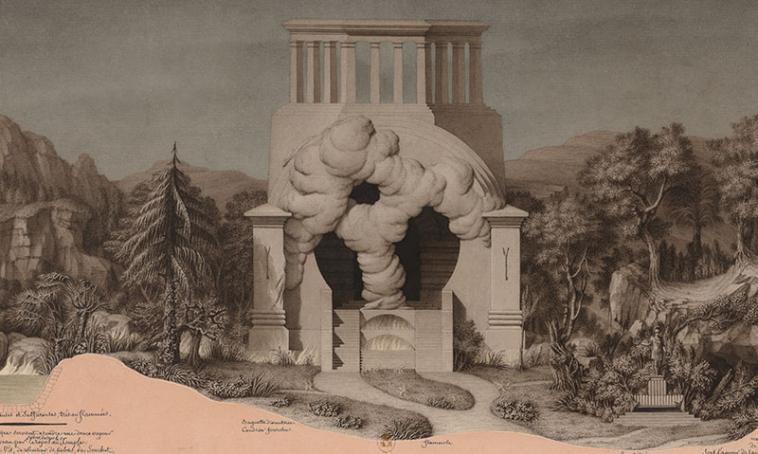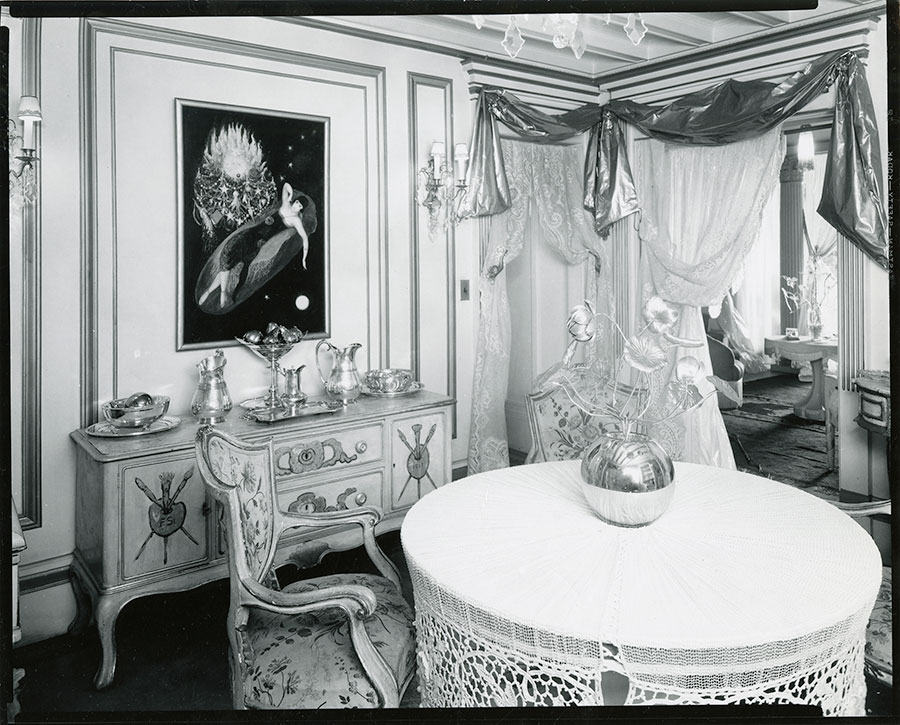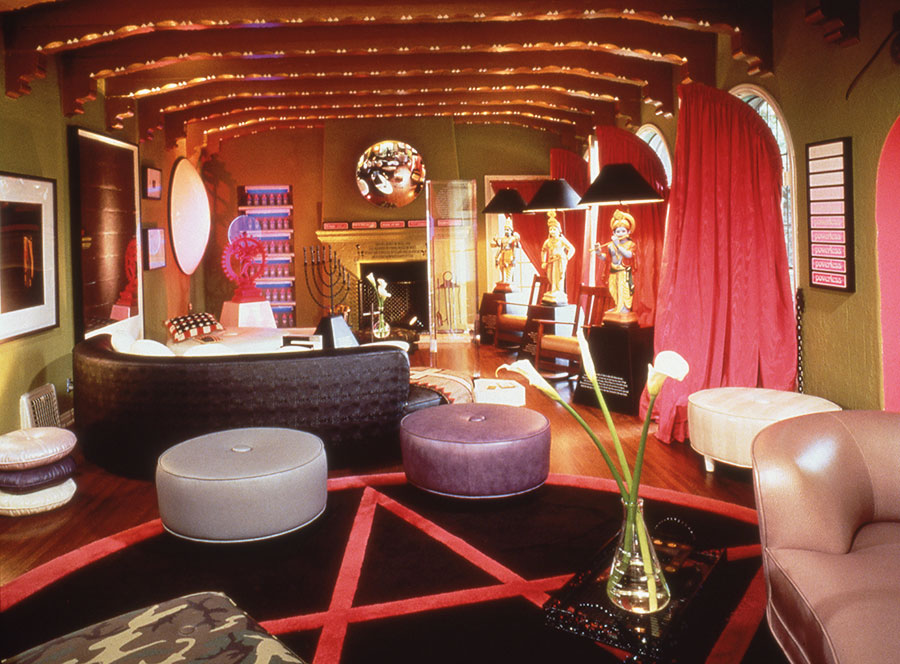HOW ARTISTS HAVE TRANSFORMED THEIR HOMES INTO OTHER WORLDS
For John Boskovich, Jean-Jacques Lequeu, Florine Stettheimer and Niki de Saint Phalle, obsessive decor served as ‘preparation for a voyage to another plane’
In a letter penned in 1782, the Marquis de Sade claimed that he knew ‘enough about architecture […] to decide if an idea is beautiful or not’. Indeed, De Sade constructed at least two complex literary edifices. The torture-sex rituals of 120 Days of Sodom (1785) are convened by a clique of libertines in the Château de Silling – an inescapable fortress with rooms dedicated to specific activities, such as desecration of the cross or narration of tales of past debauchery (to be violently re-enacted upon victims). The monastery of Sainte-Marie-des-Bois, imagined for De Sade’s 1791 novel Justine – which, unlike 120 Days of Sodom, was published during the author’s lifetime – is less infamous than the Château but somewhat more cruel. The only means of entry or exit is through a winding underground passage, and the complex is further secured by a series of thorn-encrusted hedges, an additional wall and a moat. Overgrown with vegetation, the structure is indistinct, if not invisible, from the exterior. Everyone inside can hear you scream; those outside perceive a thicket or a bosky hill. There’s a nod to the notion of the folly – that thrill of Enlightenment gardens – but Sainte-Marie-des-Bois is not a private building; it is a communal retreat for libertine monks, who maintain stable-like dorms for the objects of their interests, whom they segregate by gender. Precise order reigns throughout this corporate seraglio. Like the Château, Sainte-Marie-des-Bois evinces a fascination on De Sade’s part with, as architectural historian Anthony Vidler has written, the impossible ‘coincidence between imprisonment and liberty’.[1] Certainly, it unites De Sade with the utopian social philosopher Charles Fourier, who similarly proposed, as Roland Barthes notes in Sade, Fourier, Loyola (1976), a communitarian lifestyle in which all functions necessary for life, including coitus, are as communal as they are minutely regulated.
Although De Sade’s interiors precede the technological transformations of the industrial revolution, which transferred the means of manufacture from the home to industrial spaces during the 19th century, they do offer a vision of production that pre-empts the Victorian model. Like the meticulous, fanciful architectural drawings of his contemporary Jean-Jacques Lequeu, which concern themselves with elaborate monuments to classical spirits and genital-shaped grottos sown with smelly flowering plants, De Sade represents spaces so total, so awesome and so expansive that, once we are inside them, there really is no other place to go. In De Sade’s world, there is nothing but fantasy and ceremony, no way to wake up from the dream and absolutely no privacy – not even for the apparently empowered libertine. As for De Sade and Fourier, so for Lequeu: his structures would be impossible to realize in real life but, in the artist’s projections, currently on view in the exhibition ‘Jean-Jacques Lequeu: Visionary Architect’ at New York’s Morgan Library & Museum, bodies are effortlessly conveyed through space, combined, created and destroyed, in a sensuous narrative that – seemingly for no reason beyond personal preference – partakes synthetically of logics borrowed from the church, the abattoir, the bedroom, the classroom, the theatre, the kitchen and the prison, both past and future.
A different kind of sensuousness took hold in the Victorian era that followed. According to design historian Peter Thornton, the mid-1800s marked:
the ‘age of the crapaud’ – of the ‘toad’, the disrespectful but apt nickname given by the French to the standard, mid-19th-century, heavily stuffed, deeply buttoned and elaborately trimmed easy chair. This object, together with its sisters the sofas, confidantes, ottomans, pouffes and so forth, were the subject of derision […] but such seat-furniture embodied the true spirit of the period and was to be seen everywhere, modified ad infinitum.[2]
This was a period of ‘seat-furniture’, structures designed for sinking, fainting, zoning out, lingering, posing, pining and attending the inevitable: death. Dense massing of decorative objects and upholstery – fashionable in Europe and the US between the 1860s and the 1890s – added clutter and clashing to rooms duly padded, as if to soften the blow. A craze for drapes and fringing seems to have celebrated the increasingly extreme feminization of the private sphere with symbolic labia: indications of mysterious concealment and delicate sensations to be found only within the vessel of the home.
It was an era of the blossoming of a certain social format: the so-called separate spheres, which had emerged at the beginning of the 19th century, after the revolutions and early stirrings of industrialization. In this organization of society, domestic space pertains to the woman of the house, while the man enters into public in order to work and make known his name. The domestic arena is the site of childrearing, decor, material culture, religion and sentiment, while the public realm is a locus of action, reason, money, politics and history. Alexis de Tocqueville, who travelled to the US from France to observe the relations between men and women there, writes in a chapter on ‘How the Americans Understand the Equality of the Sexes’ in Democracy in America (1835), that ‘although the women of the United States are confined within the narrow circle of domestic life, and their situation is in some respects one of extreme dependence, I have nowhere seen women occupying a loftier position’. If our contemporary conception of privacy was popularized, if not exactly invented, during the 19th century, then it fell to women to groom and nourish this valuable civic substance. They hung it with drapes, planted it with ferns and, in the process, became enclosed and obscured along with it.
The modern object or room, by contrast, seems to partake, at its most strenuous, of an ideology of limitation: form follows function and function itself is exhaustively knowable. Thus, there can be no need for the chicory of rococo, with its folds and undulations, nor the drips, points and bead-like embellishments of the gothic, nor Victoriana’s endless tufts and patterning. The industrial aesthetic moves indoors. The ‘new woman’ has dispensed with frills, wears trousers, cuts her hair short, practises photography, smokes. The visibility promoted by modernism is remarkable: surfaces are free of encumbrance and, where not strictly administrative, work is intellectual and creative (since, in theory, much physical labour is done by machines), meaning it can take place, once again, within the home.
This said, the ideology of the separate spheres has proved stubborn, if not invincible; even as we have drifted far beyond a historical moment that can reasonably be termed modern, it remains with us. Perhaps this has something to do with the style of privacy that began to emerge in the 20th century along with the advent of mass media. As architectural historian Beatriz Colomina puts it in her book Privacy and Publicity (1994): ‘Privacy is now what exceeds the eyes.’ In Colomina’s reading of modernist design, interior space is often exposed to the exterior in what amounts not to a revelation of the private but, rather, a re-invention of public space on what were apparently private grounds. ‘Modernity’, she notes, ‘coincides with the publicity of the private.’ We need only think of the floor-to-ceiling windows, so prevalent in contemporary architecture, which provide an unobstructed view of a pristinely curated (and pointedly crapaud-free) interior.
Such was the historical trajectory of interior design. Yet, as a spate of current and recent exhibitions attests, there have always been exceptions. A number of 20th-century artists resisted the Victorian doctrine of separate spheres even as they did not fit within the massively influential paradigms proposed by the utopian era of republican revolutions or high modernism’s rejection of the purely decorative. These artists perform a sort of ambiguous installation work, designing interiors that are neither solely for aesthetic contemplation nor for autonomous living but that engage moods of monumentality, esoteric ritual and even entombment, just as they give place to ecstatic forms of daily life that cannot be reduced to work or leisure.
Two artists who lived on opposite coasts of the US during two different halves of the 20th century, Florine Stettheimer (1871–1944) and John Boskovich (1956–2006), developed a deeply weird decorative grammar that not only escapes the logics of work and privacy entailed by the ideology of the separate spheres, but also manages to differentiate itself from libertinage as well as modernism. Stettheimer, who wrote poetry and painted elaborate encrusted scenes, usually of flowers and wispy figures and fauns, was also an extraordinary decorator, favouring copious quantities of lace and doilies alongside a new translucent material: cellophane. As a mature artist, Stettheimer painted in her apartment, layering the space with various crystalline textiles in the midst of which she displayed her works, along with her collection of George Washington figurines and images. Similarly, Boskovich altered a rented Los Angeles house, presumably at significant expense, to house artworks that were also furnishings. His custom Prada-themed fridge, his use of koan-like excerpts of poems on objects and walls, along with his inclusion of religious iconography as well as medical and industrial items, gave the space, which he termed his ‘Psycho Salon’, the quality of a large mausoleum or period room for a time in history that had not yet fully come to pass. The relative obscurity of his practice at the time of his death further contributes to a masonic air of hidden ritual about the place, even as its growing fame in art-world circles contributes to its ongoing public-ness.
In his catalogue essay ‘Playing with the Truth’ (1988), Jeremy Gilbert-Rolfe sees a ‘narrative of both accessibility and arcane reference’ in Boskovich’s pristine framed juxtapositions of image and text, in which he culls language from such poets as e.e. cummings, John Keats and Octavio Paz and sets it alongside found and altered photographic imagery. Boskovich, according to Gilbert-Rolfe, is at once emphatic about ‘transparency and the idea of its opposite, or presentation and therefore the possibility of what is not present’. In his work, one category does not succeed in transforming or overwhelming the other; rather, they open up to each other in a relation not of exclusion but of addition.
If there is too much in Boskovich and Stettheimer’s rooms, it is not because there are too many things. Rather, all the items have been so obsessively placed, fixed, altered, caressed and framed that their esoteric natures, far from being domesticated, have been exactingly preserved intact and are, therefore, liberated to act upon the eyes and emotions of the resident or guest. Stettheimer was, like Boskovich, a connoisseur of the frame and had a number of lace-like frames constructed for her paintings that also matched her frothy custom furniture designs. Walking into her apartment must have been like entering an amusement park’s rendition of an ice palace, with the difference being that Stettheimer’s glittering false ice (lace, cellophane, painted wood) was not intended for public consumption and reflected her highly rarefied personal taste. Her decor pointed toward a monumental elsewhere that, in spite of her adoration for George Washington, was not exactly or uniquely nationalistic, institutional or religious in nature – even if it was devotional. Rather she, like Boskovich, seemed to be preparing for a voyage to another plane, an alternate universe or an eternal party in her honour.
Both Stettheimer and Boskovich appeared to aspire to a sort of celebratory translation of surface, an extension of reflection that shone or sparkled or glowed dimly without exactly being mirror-like, which served to externalize a complex series of moods and affinities that were not merely or purely personal in nature. Like the winding and uneven mosaic encrustations of the artist Niki de Saint Phalle’s Tarot Garden (1998), the surfaces they created were often engaged in plays of light and shade, as much as with material substance itself: Boskovich’s remarkable combinations of citric hues with powdery reds and ingenious recessed lighting being a particularly memorable manifestation of this shared tendency. In contemplating these maximalist practices of decor – the grammars of darkness and light, the hyper-precise framing, the obsessive strategizing of every surface – I am struck by their reliance on qualia, geometric form and what we might term, punning on architectural historian Lisa Heschong’s beautifully titled book Thermal Delight in Architecture (1979), ‘photic delight’. The resonances with the miniaturized landscapes and figures of amusement parks (which often allegorize fantastical worlds), as well as the sparkling gloom we might associate with chapels and shrines, suggest that we would do well to view these homes less as enclosures than as portals. These rooms indicate possibility: here and now and soon; also, elsewhere.
Date: March 19, 2020
Publisher: frieze
Format: Print, web
Genre: Nonfiction
Link to the article.
This article appears in the print edition of frieze, April 2020, issue 210, with the title "The Ecstatic Home."

Cover image.

Jean-Jacques Lequeu, Temple of Divination, from Civil Architecture, undated, pen, black ink, grey wash and watercolour on paper. Courtesy: Bibliothèque nationale de France, Paris, and The Morgan Library & Museum, New York

Florine Stettheimer’s studio at Beaux-Arts Building, New York, 1944. Courtesy: © Estate of Florine Stettheimer and Peter A. Juley and Son Collection, Smithsonian American Art Museum, Washington, D.C.

Psycho Salon, Boskostudio, Los Angeles, 1997. Courtesy: Estate of John Boskovich and O-Town House, Los Angeles
- Anthony Vidler, The Writing of the Walls: Architectural Theory in the Late Enlightenment, 1987, Princeton Architectural Press, p. 105.
- Peter Thornton, Authentic Décor: The Domestic Interior 1620–1920, 1984, Crescent Books, New York and Avenel, p. 216.